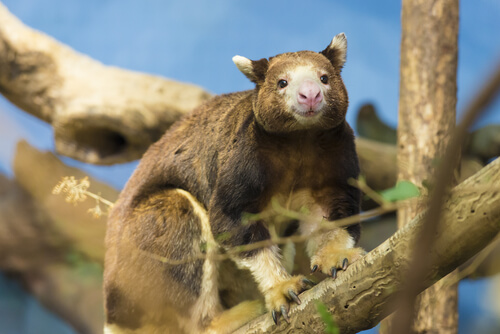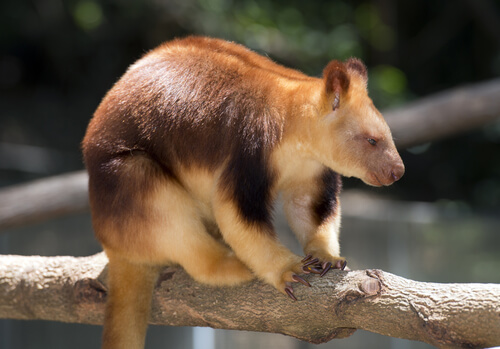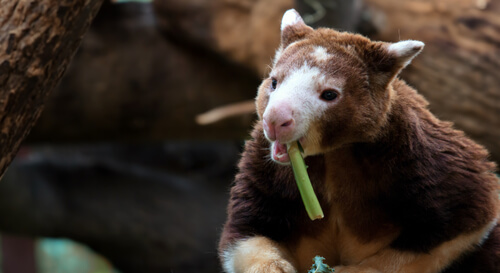
| Kingdom | Animalia |
| Phylum | Chordata |
| Class | Mammalia |
| Order | Diprotodontia |
| Family | Macropodidae |
| Genus | Dendrolagus |
| Species | Dendrolagus spp. |
| Niche | Arboreal marsupial |
| Length | 19-35 in (48-90 cm) excluding tail |
| Weight | 13-33 lb (5.9-15 kg) |
| Lifespan | 18-25 years |
| Social Structure | Mostly solitary |
| Conservation Status | Threatened, Endangered (depending on species) |
| Preferred Habitat | Forest Canopies |
| Average Litter Size | 1 joey |
| Main Food Item | Fruit, leaves |
| Predators | Dingoes, Pythons, Humans, Dogs, Cats |
The Basics
Tree kangaroo is a group of some fourteen distinct marsupial species of the genus Dendrolagus. They are known for living mostly in trees in Australia, West Papua, and Papua New Guinea. As their name would imply, they appear similar to kangaroos but are generally smaller. With a relatively small range and an ever-increasing threat from human destruction of their habitat, tree kangaroos are listed as “Endangered” on the IUCN Red List.
Tree kangaroos are endemic to the rain forests of New Guinea and northeast Australia. They are also known to inhabit other small islands in the region. Most live in mountainous regions. However, there are exceptions, such as the lowlands tree kangaroo (D. spadix). They feed on various tree fruits and leaves they will find in the treetops or sometimes scavenge from the ground.
Appearance
Like their terrestrial cousins, they hop to get around when on the ground. However, tree kangaroos have longer, thicker tails that aid in balance and locomotion. The fur on their bodies is typically various shades of brown and tan while their faces are typically a lighter cream color. Their hind feet are longer and broader, allowing them to grab tree branches and balance more effectively. Their nails are longer as well. This allows them to grip the bark of the trees when climbing. Finally, they have a unique sponge-like grip on their feet and paws that further increases traction.
Most tree kangaroo species’ general appearances are similar. However, there is a range in size between species. For example, the smallest tree kangaroo, Lumholtz’ tree kangaroo, weighs as little as 13 lbs (5.9 kg) and is about 19-26 in (48-65 cm) long excluding its tail which is almost as long. In contrast, the Grizzled tree kangaroo grows as long as 35 in (90 cm) and weights up to 15 kg (33 lb). Matschie’s tree kangaroo lies somewhere in the middle, weighing about 25 lb (11 kg) and growing to about 32 in (80 cm) long. Tree kangaroos tend to breed during the monsoon season.
Female tree kangaroos only give birth to one baby – called a joey like other kangaroos – per year. Joeys will live with their mothers until developed. At first, they will hide out in a pouch on the front of the mother, much like other kangaroo and marsupial young do.
Living Under Threat
The trees they inhabit are also home to a dangerous neighbor. The amethystine python (Simalia amethistina) also inhabits the rain forests in the same range as the tree kangaroo and is a natural predator of the species. They will prey on young tree kangaroo but are also able to take on adults of most species.

Common victims of hunting, most tree kangaroo species are threatened and some are endangered. Like most species, habitat destruction is also a primary threat to their survival. Unsurprisingly, without trees to live in, tree kangaroos are unlikely to thrive. As human-wildlife interactions increase continue to increase around the world, animals such as tree kangaroo are also susceptible to other related threats such as attack by domestic or feral dogs and cats.
Fun Facts about Tree Kangaroo!
Lost and Found
The Wondiwoi tree kangaroo (D. mayri) is on the Global Wildlife Conservation’s “Search for Lost Species” initiative’s 25 ‘most-wanted’ lost species. This is a list of species that are known to be endangered and may lack confirmed sightings in many years or more. Many live in remote or hard-to-reach areas. Thus, it is not known that they are extinct, yet it can not be confirmed that any remain either.
In 2018, a tourist took grainy photos of what may be a Wondiwoi tree kangaroo while visiting Papua New Guinea. However, the sighting is still being investigated and confirmed. If confirmed, this will be the first time this species has been seen since before the great depression of the 1930s.

No Sweat
Like terrestrial kangaroos, tree kangaroos are not adapted to sweat the way many mammals do. Sweating is a form of thermoregulation. By facilitating the evaporation of the moisture from the skin, it allows us to experience a cooling effect. Kangaroos, however, create their own sweat. Kangaroos and tree kangaroos alike will lick their forearms and allow the saliva to evaporate, producing a similar cooling effect as does sweat on the skin.
Rare But Many
When the rain forests of Australia began to dry during the Late Eocene, the new rockier environment led to the evolution of animals such as the rock-wallaby (Petrogale spp.). Rock wallabies were ancient marsupials that became generalist feeders due to their reliance on various types of vegetation. Later, as some of the rain forests previously common to Asia began to colonize Australia, rock wallabies thrived due to this generalist strategies. Inevitably, they would begin to adapt to climb and dwell in trees, eventually giving rise to a now extinct type of tree kangaroo of the genus Bohra.
Again, as the continent dried during the global cooling of the Pleistocene, rain forests contracted. Many populations of Bohra were eventually isolated from one another, ultimately allowing for the evolution of modern-day tree kangaroos of the genus Dendrolagus.
Unfortunately, the tree kangaroo’s habitats continue to shrink. However, this human-caused destruction of their habitat occurs at a much more rapid pace than the evolutionary processes described above which occur over millions of years or more. This time, instead of evolving, tree kangaroos are more likely to become extinct altogether.
